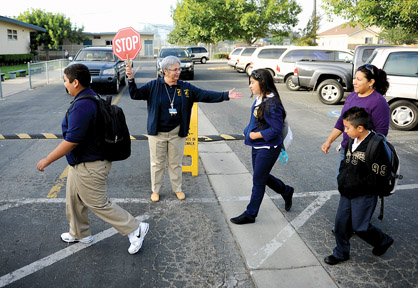
Efforts to stop ‘zombie drivers’ from being distracted behind the wheel will happen statewide this month
Efforts to stop ‘zombie drivers’ from being distracted behind the wheel will happen statewide this month
The Hollister Police Department, the California Highway Patrol and the San Benito County Sheriff’s Office will be concentrating enforcement of traffic laws around Hollister schools in an effort to encourage drivers to drive safely in school zones.
The Hollister Police Department, along with the California Highway Patrol and the San Benito County Sheriff’s Office, will be conducting traffic enforcement/awareness around the school zones of the Hollister area.
Officers will patrolseveral specified school zones looking for traffic violators. These focused patrols will be conducted within the month of April and during school hours.
The goal of this concentrated effort is to bring awareness to motorists on the importance of driving safely and defensively within school zones.
In addition to the efforts near schools, the California Highway Patrol in April will be targeting distracted drivers who are using cell phones or texting while driving. They are referring to these inattentive drivers as “zombie drivers.”
“April is distracted driver awareness month and we are trying to bring it to public awareness,” said Allen Stallman, the CHP commander for Hollister-Gilroy. “We are looking to develop a collaborative for working with the Hollister Police Department – reaching out to get the most dollars for taxpayers.”
The California Highway Patrol (CHP) along with the California Office of Traffic Safety (OTS), Impact Teen Drivers, and law enforcement agencies statewide are preparing to launch the second annual National Distracted Driving Awareness Month campaign, “It’s Not Worth It!”
During the campaign kickoff month in April 2011, more than 52,000 citations were issued by law enforcement statewide, four times the monthly average. A first-time citation will cost a minimum of $159, with a second violation at least $279.
“Drivers need to ask themselves, ‘Is that phone call or text message worth my life or the lives of those around me?’” said CHP Commissioner Joe Farrow. “The answer is simple; it’s not worth it. Every distraction affects a driver’s reaction time, and things can change without notice.”
In recent years, hundreds of people have been killed in California, while thousands were injured, as the result of collisions that involved at least one driver who was distracted. This distraction can be any activity that diverts the driver’s attention away from the primary task of driving. According to a study conducted by Carnegie Mellon University, the act of talking on a cell phone can reduce more than 35 percent of the brain activity needed for driving. Essentially, distractions change a seemingly good driver into a “zombie” behind the wheel.
To dramatize this “zombie-like behavior behind the wheel, zombies are being added to this year’s “It’s Not Worth It” campaign. The campaign will be supported by statewide grassroots outreach, social media activities and television commercials that encourage people to focus on the road and not be a “zombie” driver.
“Law enforcement sees firsthand the devastation caused by distracted driving and the needless pain associated with the senseless collisions that follow,” added Commissioner Farrow. “I am grateful that so many of the state’s law enforcement agencies are joining us in this important traffic safety endeavor again this year.”
More than 200 local law enforcement agencies and 103 CHP offices will be participating in the monthlong, life-saving effort. Similar to the previous year’s campaign, there will be both an enforcement and educational component. The overall goal is to reinforce to the motoring public the dangers of distracted driving and reduce the number of people impacted by this destructive behavior.
”Parents and other adults need to set a positive example,” said OTS Director Christopher J. Murphy. “Start by never calling or texting anyone, especially your kids, when there’s a possibility they might be driving. Then let that same action follow you when you are the driver.”
Among the more than 1,800 drivers over the age of 18 who participated in last year’s annual statewide traffic safety survey conducted by OTS, talking and texting on a cellular telephone were rated the two biggest safety problems on California’s roadways. In fact, talking on a cellular telephone (handheld or hands-free) was identified as the most serious distraction by 56 percent of the respondents.
Adults are not the only offenders when it comes to distracted driving. According to the National Highway Traffic Safety Administration, teen drivers are more likely than any other age group to be involved in a fatal crash where distraction was involved.
“Teens, even more than adults, are accustomed to using technology to have instant access to their friends. It’s not only technology – teens are frequently distracted by loud music, passengers, and other everyday tasks that, when done behind the wheel, become lethal,” said Dr. Kelly Browning, executive director of Impact Teen Drivers. “These everyday distractions, coupled with inexperience, often have deadly consequences.”
This year, National Distracted Driving Awareness Month coincides with California Teen Safe Driving Week, which is the first week of April. For nearly five years, Impact Teen Drivers, a nonprofit organization, has been providing awareness and education to teenagers, their parents, and community members about all facets of responsible driving, with the goal of reducing the number of injuries and deaths suffered by teen drivers as a result of distracted driving and poor decision making.
Age aside, California’s traffic safety partners are asking for the public’s help in making this April’s distracted driving awareness campaign successful.
“It is important to note that the success of this campaign is not measured by the number of citations the officers write, because we are hoping that by calling attention to this effort we will gain voluntary compliance,” added Commissioner Farrow. “The success of the campaign is measured by the number of lives saved.”








